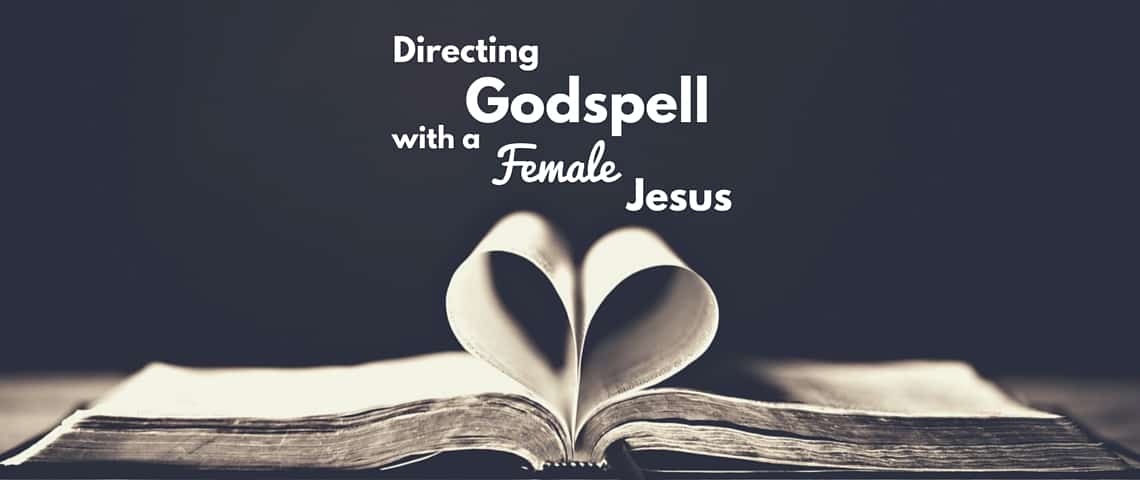“Do you care if Jesus is a righty or a lefty?” Jasmine Myers asks during a rehearsal for Godspell. She’s just finished showing me the sign language translation she’s created for the chorus of the song “Beautiful City.”
“You’re a lefty,” I respond, “Do whichever’s more comfortable for you.”
In Still Small Theatre’s upcoming production of Godspell, Stephen Schwartz and John-Michael Tebelek’s quirky musical retelling of the Gospel, Jesus is left-handed and prays in sign language. Jesus gets the group’s attention by imitating a Southern Baptist preacher, turns a card-reading session into a game of Go Fish, and gives a lot of hugs. Jesus wears a patchwork skirt and a flower crown. In this production, Jesus is a woman.
—
The idea of casting a female actor in the role of Jesus is not unique to Still Small’s Godspell. In school and community theatre productions, the roles of Jesus and Judas are often played by female actors. And in some cases it can work quite well.
Jasmine Myers, Still Small co-founder and CEO, portrays Jesus in our production of Godspell. “I do get a little nervous that people might think we’re being ‘revisionist’ or disregarding the historical Jesus,” she writes, “but then again, while the historical Jesus wasn’t a woman, neither was he white, or a speaker of English, and we generally understand when watching white English-speaking actors portray Jesus that the actor is helping us to connect with who He is more than what He was.”
Our Godspell takes place in Salem, MA: a city whose infamous history has shaped its present culture, for better or for worse. “We’re performing in a place where a lot of people have been very wounded by religion, and where a lot of people associate Christianity with destructive patriarchal attitudes,” Jasmine writes. “Many are suspicious of Christianity, many have very skewed ideas of who Jesus is and what He stands for, and many feel safer around women. Ironically, playing Jesus as a woman may be key to helping our audience connect with the real Jesus.”
The Jesus we see in the Gospels was a true ally to women in a society that was far less egalitarian than twenty-first century America. I am always struck by His interactions with the Samaritan woman at the well, with the woman caught in adultery, with Martha and Mary of Bethany, and so many others: by His validation of them outside of the roles society has placed them in, His refusal to condemn or allow anyone else to do so. They are as welcome as anyone else to learn from Him, offer their gifts to Him, and present their requests to Him––and often they understand what Jesus is about better than His male followers do.
That was one of the reasons I decided we would not try to conceal the fact that the actor playing Jesus is a woman. I want our audience to see a community where women do not have to hide or apologize for their femininity in order to be accepted, valued, and honored.
In this show,
- John the Baptist recognizes Jesus as the rightful leader of the group, giving up his own leadership role to follow her.
- Male and female disciples both recognize that they have something to learn from this person.
- She doesn’t play power games or try to manipulate the men in the group.
- They don’t belittle her ideas or reject her authority simply because she is a woman.
It sends a powerful message about what female leadership can and should look like. And it also broadens our perspective of who God is beyond patriarchal authority.
“One of the exciting things about playing Jesus as a woman is that it will hopefully help people to break out of the mindset of thinking we’re supposed to visualize God as male,” Jasmine writes. “Genesis refers to the image of God as ‘male and female’; the Holy Spirit is referred to with a feminine noun in Hebrew (Ruah), and so if we can’t see the feminine in God, we’ve got a problem. And it’s not just a theoretical or semantic problem; it’s a problem for the myriad of people in our society who are, for one reason or another, in great need of feminine love. Human beings seem wired to fulfill their intimacy needs by any means possible; how can we expect people to overcome broken maternal relationships and keep from having destructive relationships with women, if they cannot receive motherly love from God? It is our hope that this portrayal of Jesus will help people be able to receive that love.”
—
We’re rehearsing a scene in the second act where Jesus stops the rest of the group from stoning a woman who “was caught in the very act of adultery” by telling them, “That the one of you who is faultless shall throw the first stone”. Jasmine kneels on the floor, placing herself between the cowering woman and the departing crowd. She looks up at me. “I was thinking of a mom hug here,” she says, “Would that be okay?”
“Let’s see it,” I reply.
Still on her knees, she hugs the other woman, in a gesture that is both comforting and fiercely protective. She holds her for a long moment. She kisses her on the forehead. If she were a man, this kind of intimacy would mean something very different. But coming from one woman to another, there are no strings attached; just complete acceptance, unconditional love.
Everything I want my co-workers, my neighbors, and friends in this city to know about Jesus is summed up in that hug. Maybe some people will be put off by this casting choice. But maybe others will see God’s love for them in a way that they never have before, and I hope it will lead them one step closer to the outstretched arms of the real, living Jesus.





11 responses to “Directing Godspell with a Female Jesus”
I wish I could see the production. The description of the ‘mom hug’ has touched me in a surprising way.
Thank you so much, Jonathan!
For those of you who are interested in seeing future productions or connecting with Still Small, our website is http://www.stillsmalltheatre.com and our FaceBook page (thanks for mentioning this, Gail!) is http://www.facebook.com/stillsmalltheatre .
We tour our shows, including one (“The Diary of Perpetua”) that is based on one of the earliest female-authored documents known to history, and we are always trying to listen to the Holy Spirit on how to make God’s heart visible and accessible to the world.
Thanks & many blessings!
Jasmine
I’m actually curious about the use of “sign language” here. Are you referring to American Sign Language, or to one of the many signed systems for English that hearing people have created?
I’m curious because, while American Sign Language is a full, complex & beautiful language created by Deaf people, what I usually see out of churches is the use of some form of PSE (Pidgin Sign English), which is not a language at all, but rather a code used in schools to oppress Deaf children, forcing them to focus on English & punishing them for using their natural language. The appropriation of “ASL” (usually signed badly) by hearing churches has a long history in the United States.
How are y’all approaching this? Do you run all your translations by Deaf community members, or better yet, are the translations done by Deaf people? Are Deaf community members included in your production team? Are they treated as equals? Do they have control over the ways that their language is used?
Thanks for engaging with me & I look forward to your response.
Hi there! For some reason your comment went straight to our spam box and I just found it! The faster way to contact the author would probably to leave a message through her Facebook page: https://www.facebook.com/stillsmalltheatre/. We can also send her a note about your comment. Interesting topic!
Thank you for your question! I should have clarified and said American Sign Language. The woman who played Jesus had studied ASL in college, and she asked if she could incorporate it into the show––specifically for that song, but it ended up being used throughout the show at key moments. I was also worried about appropriation, because I know that ASL is beautiful and complex language and I didn’t want to be using it in a way that was disrespectful to the Deaf community.
Because this idea came up fairly late in the production process, I was unfortunately not able to get in touch with members of the Deaf community to help with translations. But a friend of mine who is fluent in ASL and works with Deaf people did our translations. I know this probably was not the best way we could have gone about this, and I sincerely hope we didn’t cause offense to any members of the Deaf community who might have happened to see our show.
The reason Jasmine wanted to use ASL in that particular song was to clarify that Jesus is addressing the song as a prayer to God the Father––we wanted some way to make it clear that the phrase “We can build a beautiful city” does not refer to humans making things right by their own efforts, but to the hope that the work Jesus has started with this group of people will continue through the Holy Spirit even after Jesus is no longer physically present with them (in the show, “Beautiful City” comes right before the Last Supper; we saw it as a parallel to Jesus’ prayer in John 17).
This developed into the concept that, within the world of this show, ASL is the language Jesus uses to communicate with the Father, a visual representation of the unique bond they share (which is something that often goes overlooked in Godspell). At certain points in the show, Jesus would teach the disciples signed words or phrases, because the ultimate goal is for them to know God as their Father and to share in that intimate relationship with Him that goes beyond spoken words. I fell in love with this idea too much to not do it. If I were to consider doing something like this again, I would not do it without the involvement of the Deaf community. As it was, I trust the friend who did our translations––she has done theatrical interpretation, and so she not only made sure that the actors were signing correctly, but also that the translations made sense dramatically. Using ASL in this way added an emotional depth to the show that it had been missing before. I hope we were able to do it in a way that was respectful and appropriate.
Amelia, thanks for your helpful and detailed response to this question. We appreciate it!
Thanks so much for your reply! Sorry I didn’t see it sooner, I’ve been overwhelmed by life 😉
You’ve got the right attitude & I think that if you ever do a coproduction with Deaf artists it’ll be a challenging learning curve & a really great experience for you.
It can be difficult to ensure that you’re really producing something respectful of Deaf community, language & culture. I’ve known lots of interpreters who come across as super confident & talk a big game, but really don’t sign well & don’t have strong ties to Desf community or even any Deaf friends. Often Deaf people will tell hearing people that what they’ve done is “fine” simply because the hearing people haven’t worked to earn the trust of the Deaf people their asking, so the Deaf involved wisely choose not to waste their time trying to educate hearing people who didn’t bother to consult with them in the beginning.
So it’s a complex situation to jump into, but well worthwhile. I hope you get all the right opportunities to meet Deaf artists through your interpreter friends & to go see a few Deaf productions & learn from their culture!
Blessings <3
A “mom hug”! Gorgeous, beautiful and just what Jesus would do!
( I am nearly in tears!) I so wish I could see this production.
Thank you, thank you, thank you! <3
I love this so much. I wrote a fantasy novel in which the Redeemer is a woman, and I get a LOT of pushback on it from people who cannot conceive of female divinity. Which is one reason this book isn’t published yet. I pray this production does well. We so need these kinds of challenges to people’s assumptions about deity.
Thank you so much, Kristen! Interestingly enough, both Jasmine and I also write and are working on fantasy stories with female Christ-figure characters. Hers was intentional from the beginning; mine didn’t start out that way, but while writing about the protagonist’s love for her runaway children, it suddenly struck me that that was how God loves us. It helped me to understand God’s love in a way I had never even thought of before, even though there’s plenty of maternal imagery used in the Bible to describe God’s love, because we just don’t ever really talk about it. I pray that your book will be published. I, for one, would love to read it. We need more of these kinds of stories.
Thank you so much! I’ve been working on some projects like that too — I’ll pray for your work as well!